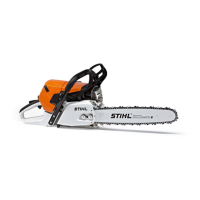MS 441
English
51
Definitions
1 Carburetor Box Cover with Clips.
Lock for carburetor box cover.
2 Carburetor Adjusting Screws.
For tuning the carburetor.
3 Handle Heating Switch (Special
Option).
For switching the electric handle
heating on and off.
4 Spark Plug Boot.
Connects the spark plug with the
ignition lead.
5 Shutter.
With summer and winter positions.
Carburetor is heated in winter
position.
6 Decompression Valve –
(autmatically resetting).
Releases compression pressure to
make starting easier - when
activated.
7 Chain Brake.
A device to stop the rotation of the
chain. Is activated in a kickback
situation by the operator's hand or
by inertia.
8 Chain Sprocket.
The toothed wheel that drives the
saw chain.
9 Chain Sprocket Cover.
Covers the clutch and chain
sprocket.
10 Chain Catcher.
Helps to reduce the risk of operator
contact by a chain when it breaks or
comes off the bar.
11 Chain Tensioner.
Permits precise adjustment of chain
tension.
12 Bumper Spike.
Toothed stop for holding saw steady
against wood.
13 Guide Bar.
Supports and guides the saw chain.
14 Oilomatic Saw Chain.
A loop consisting of cutters, tie
straps and drive links.
15 Oil Filler Cap.
For closing the oil tank.
16 Muffler.
Reduces engine exhaust noise and
diverts exhaust gases away from
operator.
17 Front Hand Guard.
Provides protection against
projecting branches and helps
prevent left hand from touching the
chain if it slips off the handlebar. It
also serves as the lever for chain
brake activation.
18 Front Handle.
Handlebar for the left hand at the
front of the saw.
19 Starter Grip.
The grip of the pull starter, for
starting the engine.
20 Fuel Filler Cap.
For closing the fuel tank.
21 Master Control Lever.
Lever for choke control, starting
throttle, run and stop switch
position.
22 Throttle Trigger.
Controls the speed of the engine.
23 Throttle Trigger Lockout.
Must be depressed before the
throttle trigger can be activated.
24 Rear Handle.
The support handle for the right
hand, located at the rear of the saw.
25 Rear Hand Guard.
Gives added protection to
operator's right hand.
Guide Bar Nose.
The exposed end of the guide bar.
(not illustrated, see chapter
"Tensioning the Saw Chain")
Clutch.
Couples engine to chain sprocket
when engine is accelerated beyond
idle speed. (not illustrated)
Anti-Vibration System.
The anti-vibration system includes a
number of anti-vibration elements
designed to reduce the
transmission of vibrations created
by the engine and cutting
attachment to the operator's hands.
(not illustrated)

